I have removed the link to this article from my website, but I haven't deleted it completely. If you got here directly from a search: I found a news blurb in a magazine called Movie Makers, October 1931, pp. 544 and 548. I am quoting it here in its entirety:
A radically new type of exposure meter makes its appearance this month, operating on the light sensitive cell principle. The idea has been advanced theoretically many tiems and cine workers have been promised that this principle would some time be brought to their aid in solving the vexing problem of exposure but the firm of J. Thos. Rhamstine, 501 East Woodbridge Street, Detroit, Michigan, is to be the first to make this principle available to the amateur. The Rhamstein Electrophot is entirely automatic in its operation and requires no visual judgement whatever on the part of the user. It comprises a round, metal container about three inches in diameter and two inches in width, with a button at one end and a tube at the other which contains the light sensitive cell. The tube is normally closed by a cap but, when the cap is removed, the light sensitive tube pointed toward th object reflecting the the light and the contact button pressed, a pointer on a dial set in the face of the instrument immediately indicates the stop number to be used. Its scale reads directly from ƒ/1 to ƒ/32 and the needle readeing is "dead beat" i.e., does not vibrate after reaching the indicated stop. Energy for actuating th epointer is derived from two small dry cells of the "fountain pen" type which are easily replaced by removing three screws at the back of the meter. Since the energy consumption is extremely small, the life of these cells is said to be longer than six months, even in constant use. The meter reading may be adjusted through a reasonably wide range by turning a small post through an opening in the back. Succinct directions for its use and a condensed filter compensation chart are printed on the reverse side of the meter. A handy carrying case with strap of black leather is included with the meter. It is stated that the Rhamstine Electrophot will be made available during the month of October, as soon as final manufacturing arrangements are made.
This obviously negates my thesis that Weston made the first meter. My original article follows: I'm going to delete it later.
Who Invented the Modern Exposure Meter?
by James Ollinger
Who invented the automobile? It depends on how you define "automobile." Most definitions give the credit to Karl Benz, but people had been experimenting with automobiles for almost a century prior, and you have to go to the 1912 Cadillac to find something close to what we have today. Marconi is popularly considered the inventor of radio, though Nikola Tesla and others often get credit; but it was Howard Armstrong who took Lee DeForest's Audion vacuum tube and made it into an amplifier, which transformed radio into something useful and practical. The Wright Brothers invented a 3-axis control system and applied it to Otto Lilienthal's glider to make the airplane.
Most practical inventions aren't created so much as developed over time.
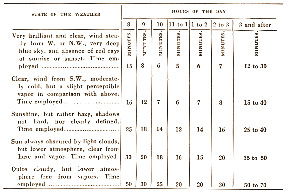 |
| Recommended Exposure Table, circa 1840 |
The invention of the photo-electric meter is one of the haziest examples of "invention." Since the early days, photographers have looked for fool-proof ways to measure the quantity of light on a subject so that they could determine proper exposure. For most of the 19th century however, when most photographers made their own emulsions from scratch and sensitivity was so low that exposures were measured in minutes, past experience trial and error was the most effective method. But as materials began to be mass-manufactured, standardization and batch-differences narrowed and the results became more repeatable. And as photo-chemistry and optics advanced, exposure times dropped into fractions of a second and exposure accuracy became increasingly important.
The earliest photographers compiled and consulted tables, which at least got them in the ballpark. Well, maybe. The problem with tables, then and now, is that there's a whole world of possibilities for interpretation. How bright is cloudy bright? What if it's partial overcast at a high latitude on a mid-summer's day, which can very different than partial overcast at a low latitude on a mid-summer's day?
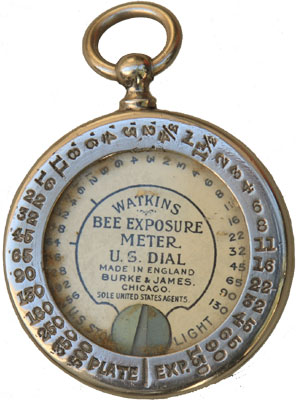 |
| Actinometer, circa 1900 |
Instruments and other aids began to appear as a way to evaluate light. The actinometer used printing-out-paper (called pop), which turns dark on exposure to light without needing chemicals, enjoyed a heyday around the 20th century. A typical actinometer looked like a pocket watch and it had a pie-shaped sliver cut in the face. Discs of pop were placed inside the case. To take a reading, the user would rotate the pop to uncover an unexposed wedge, then time how long it took the wedge to darken to the point where it matched a reference shade of grey. The photographer then looked up the time on a chart and that gave him time-aperture combinations. Not a bad system, but pop didn't always react to light the way film did, they had to be loaded in the dark, and comparing shades of gray requires a lot of subjective judgement.
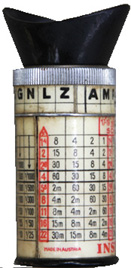
|
| Extinction meter, circa 1925 |
Extinction meters became popular in the early 20th century. To use them, the photographer would peer through the meter at the scene and see a series of gradually darkened numbers or letters. The letter that was faintest but still viewable was then looked up on a table, and time/aperture combinations could be found. The idea was that the brighter the scene, the more items on the scale would be visible. Unfortunately the human eye has a live iris that adjusts automatically, so the meters were not as good as the originally idea sounded. Still, they were very inexpensive to produce and if used very quickly and often enough to get the hang of it, they were better than nothing.
A better version, but larger and heavier and thus mostly used in laboratories, included some sort of light standard (like a little light bulb) that could be directly compared against an unknown. The user would dial a graduated filter or adjust an aperture until the unknown light source and the "standard" were judged equal. The settings used to make the adjustments could be looked up in a table or on a calculator dial to determine the amount of light seen. This method was still being used well into the 1970s as the highly regarded S.E.I Photometer.
But all of these methods were subjective. They required the photographer to make judgements and interpretations. What many people wanted was an objective method to measure light—something that would be repeatable and not affected by optical tricks or judgement or human eyesight.
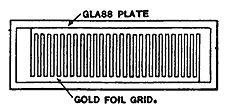 |
| Gripenberg cell, 1913 |
With the development of electrical engineering in the late 19th century, the best candidate appeared to be the selenium cell, as invented by Charles Fritts in 1884. The Fritts cell was a layer of selenium metal mounted on a copper plate. A transparent layer of gold was layered over the top of the selenium. The electrodes tapped the copper and the edge of the gold. When light struck the selenium surface, electricity flowed through the circuit. Since electricity was being produced, this was called photovoltaic, something that produced current.
The problem was the Fritts cell was that it put out a tiny little bit of electricity; so much so that it required a very sensitive ammeter to measure the current. That was possible in a laboratory, but impractical for anything else. But that was in the late 1800s. By the end of the First World War, the state of the art had progressed to where ammeters were smaller, more sensitive, and more practical for this kind of application. But they weren't quite there.
Enter the photoresistor, around 1913. This is a variation of Fritts selenium cell, called the Gripenberg cell. This time the slim gold plate is cut into an extremely long conductive surface. Each electrode is tied to one end of the gold trace, so that an electrical current flows across the top of the cell.
So what happens is that an outside electrical current sent along the gold trace. The selenium influences the conductivity of the gold. When no light strikes the cell, the gold is extremely resistant and very little current passes. As light strikes the cell, however, the resistance drops. An ohmmeter measures the resistance across the cell; the lower the resistance, the more light is striking the cell.
This changed things, because now instead of measuring a trickle of a current with a highly sensitive meter, you could instead apply a larger current and measure the resistance. That was very do-able.
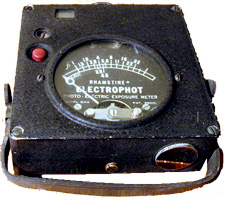 |
| Rhamstine Electrophot, 1931 |
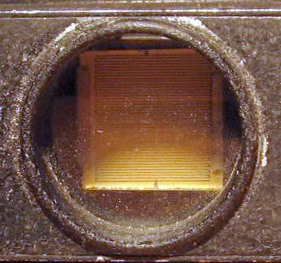 |
| Electrophot's Gripenberg cell |
To the best of my knowledge, and I'm going solely by what I see here, this is the basis of the Electrophot meter. Manufactured and sold by J. Thomas Rhamstine out of Detroit, Michigan, many argue that this is the first photo-electric meter that was commercially sold (an ad appeared for it in a 1931 issue of Home Movies magazine). The Electrophot used batteries, which in the late 20s were not the dainty little things they are today. And if you look at the business end of the meter, you can see the cell very clearly. Does that look like a Gripenberg cell to you? Does to me, too.
The Electrophot was heavy, weighing in at around 1-½ lbs.: it's luggable. While it could be used in the field, it's much more likely it would be used in a studio where its size and weight weren't such a problem, and that if the battery died, it could be more easily replaced.
There was also this stuff called Alnico. Invented by Tokushichi Mishima in Japan in the late 20s, Alnico was a mixture of Aluminum, Nickel, Cobalt (hence AlNiCo) and other elements, which made a far better permanent magnet than anything previously known. Photo-electric light meters use ammeters which measure the amount of electric current flowing through them, and ammeters require permanent magnets as part of their construction.
What Alnico magnets did was make the ammeters a lot more sensitive because they required a lot less current to run. Now a meter could directly measure the tiny amounts of current that a Selenium cell could generate. No batteries necessary.
So much for the internal works. Let's look at the meter face and the whole front side. You read the illumination level on the meter face but that's it. You had to flip it on its back to look up the result on a table to get useful results.
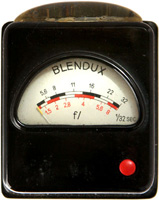 |
| Gossen Blendux, 1933 |
Some people will argue that the Gossen Ombrux (as it was called in Germany. In England it was the Blendux) might be the first photo-electric meter, because unlike the Rhamstine, it used a Fritts photovoltaic cell, probably had an Alnico magnet and didn't need a battery. Because it lacks that battery and a lot of the support, it's much smaller and lighter. The case is Bakelite, like metal, and it's about the size of a fat pack of cigarettes. Philip Gossen's microammeter was good enough to pick up that tiny current and still strong enough to take a reasonable amount of knock-about use in the field.
Gossen's meter came out in 1933, about the same time as the Weston Model 617, and it's very likely they were developed concurrently. Chronologically they're both beaten by the Electrophot, but the Gossen is much more practical for the photographer, and very close to what eventually became the state of the art for the next 30 years: a photovoltaic selenium cell in a battery-less circuit.
The Ombrux also has a specialized face, a direct-read aperture scale for 1/32nd shutter speeds. For anything else, tables were available to read the proper exposure based on film stocks and other shutter speeds.
But to my mind, the first real photo-electric meter was the Weston Model 617, which was introduced in 1932. Even though it is a year younger than the Electrophot, it is credited with creating the market for photo-electric meters. Why?
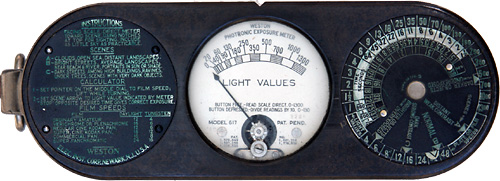 |
| Weston 617, 1932 |
I think it's because when you look at the 617, you see the future. Key features that defined photo-electric meters for decades are here. First, it's a reflected meter; the twin selenium cells on the back are covered with a lattice work of baffles that cut the angle of the light rays so that the meter "sees" the world the way a standard camera would. The Electrophot simply had the cell sitting behind an open aperture, and the Ombrux had a glass glob that scrambled the light into a sort of average, making it an early version of an incident meter.
The 617 weighs about half as much; it's long, but it's got grooves going across the top and bottom, and if you hold the meter as it was meant to be used, at eye level and pointed at the subject like a pair of binoculars, this meter fit the hand nicely. It's big and heavy, but only by modern standards. It's nicely balanced and well engineered.
But in my opinion the most important part is the calculator dial on the front, right next to the meter face. It allows the photographer to read the meter and quickly transfer the result into the calculator, right there while observing the scene. Other meters, be it the Electrophot, the General Electric that soon followed, even Weston's own second version of the 617, were really just light-level meters: you read the light level and then consulted a table. The table might be on the back of the meter (as the Electrophot) or in a separate booklet (the Gossen and General Electric), but they were always somewhere else. This Weston put it on the meter itself, right up front where it was most useful: right next to the meter face.
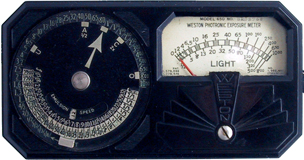 |
| Weston 650, 1938 |
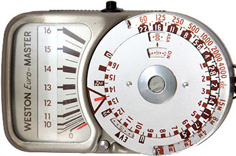 |
| Weston Euro-Master, 1980 |
A few years later, Weston's ammeter was sensitive enough to need only one cell, so they shrunk the meter and lightened it for one-handed operation. Yet the basic configuration is the same: meter face and calculator dial right next to each other, the cell on the back looking out at the reflected light of the world. They carried that basic configuration in one form or another through the end of the 20th century, and it's echoed countless times in other makes of meters made in every part of the world.
The difference between the Weston 617 and its contemporaries is that the others were basically light-level meters that were applied to photography; the 617 was a photographer's tool. It was the synthesis of several developments brought all together for the first time to define what would become standard. That's what broke it apart from the others and made it a success. It is, as far as I can see, the first real exposure meter.
